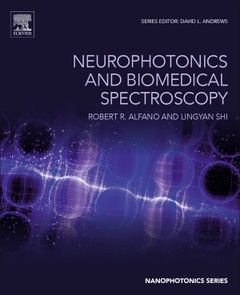Description
Neurophotonics and Biomedical Spectroscopy
Nanophotonics Series
Coordinators: Alfano Robert R., Shi Lingyan
Language: English
Subject for Neurophotonics and Biomedical Spectroscopy:
Keywords
Absorption coefficient; Airy beam; Alpha-synuclein; Anisotropy factor; Awake brain imaging; Basal-cell carcinoma; Beam shaping; Bessel beam; Biomedical imaging; Bioorthogonal labeling; Brain and prostate tissues; Brain cancer margin assessment; Brain tumor imaging; Brain tumor; Brain vascular imaging; Breast cancer; Cancer diagnosis; Cerebral autoregulation; Cerebral blood flow; Cerebral hemodynamics; Coherent Raman scattering; Coherent signaling; Developmental biology; Diffuse optics; Discrete particles; Drug monitoring; Dye laser; Dye molecule; Electrically excited; Electrically pumped; Energy transfer; Fluorescence lifetime; Fluorescence; Fluorescent probes; Frequency doubling; Functional biomarker; Functional imaging; Gastrointestinal screeningIn vivo microscopy; General anesthetics; Glioblastoma multiforme (GBM)Gliomas; Glioma tumor; Hemodynamics; Holography; Hyperspectral imaging; Imaging; Indoleamine 2; 3-dioxygenase; Infrared spectroscopy; Interferometric emitter; Intrinsic fluorescence; Kynurenine; Laser isotope separation; Laser oscillator; Light-sheet microscopy; Machine learning approach; Malignant melanoma; Medical imaging systems; Membrane potential; Meninges; Microelectromechanical (MEMS) systems; Microscopy; Mie theory; Mueller matrix; Multimodal diagnostics; Multiphoton microscopy; Native fluorescence; Near-infrared spectroscopy; Neural activities; Neurophotonics; Neuroscience; Neuro-surgery; Nevus; Nonlinear complexity; Nonlinear optical microscopy; Optical biopsy; Optical coherence tomography; Optical sectioning; Optical spectroscopy; Optical tomography; Optical-resolution photoacoustic microscopy (OR-PAM)Q-switch; Optogenetics; Organic dye; Organic laser; Oxygen metabolism; Oxygenation Variability (OV) index; Peripheral artery disease; Photoacoustic microscopy; Photobiomodulation; Photonic crystal fiber; Phototherapy; Polarization; Prefrontal cortex; Quantum biology
610 p. · 19x23.3 cm · Hardback
Description
/li>Contents
/li>Readership
/li>Biography
/li>Comment
/li>
Neurophotonics and Biomedical Spectroscopy addresses the novel state-of-the-art work in non-invasive optical spectroscopic methods that detect the onset and progression of diseases and other conditions, including pre-malignancy, cancer, Alzheimer?s disease, tissue and cell response to therapeutic intervention, unintended injury and laser energy deposition. The book then highlights research in neurophotonics that investigates single and multi-photon excitation optical signatures of normal/diseased nerve tissues and in the brain, providing a better understanding of the underlying biochemical and structural changes of tissues and cells that are responsible for the observed spectroscopic signatures.
Topics cover a wide array of well-established UV, visible, NIR and IR optical and spectroscopic techniques and novel approaches to diagnose tissue changes, including: label free in vivo and ex vivo fluorescence spectroscopy, Stoke shift spectroscopy, spectral imaging, Resonance Raman spectroscopy, multiphoton two Photon excitation, and more.
Part 1: Topics in Optical Spectroscopy Biopsy 1. Origin of tissue optical properties 2. Optical methods for tissue diagnosis and treatment 3. Methods for in vivo assessment of physiological state of tissue 4. Excitation, absorption, scattering fluorescence spectroscopy 5. Resonance Raman spectroscopy 6. Inelastic light scattering spectroscopy and imaging 7. Stimulated Raman gain spectroscopy and imaging—NIR optical windows in 700 nm to 2500 nm 8. Coherent and non-contact photo-acoustic imaging 9. Polarization and diffusive reflectance spectral imaging time resolved spectroscopy single and multi-photon excitation and imaging 10. Mid infrared diagnostic methods 11. Nano particle tagging and contrast agents optical metabolomics Demos, Gansean 12. Supercontinuum for medical and biological applications 13. Stokes shift spectroscopy
Part 2: Topics in Optics in Brain 14. Alzheimer’s Disease Optical Imaging in vascular impairment 15. Hemodynamics by NIR in Brain, and Overview View summary of field 16. Blood Barrier in mice using two photon and ultrasound 17. Overview of Infrared neural stimulation 18. 2Photon excitation in brain 19. Overview NIR correlation spectroscopy in brain 20. Overview of Optical Coherent Tomography in neuron tree 21. IR stimulation in spinal nerves 22. Ca+2 channels in brain by multiphotons 23. Ca2+ flow in brain by multiphotons 24. Overview Ca2+ indicators by 2PEF 25. Control Biosystems using optogentics 26. Optogenetic circuit mapping with traditional whole cell patch clamp to determine synaptic connectivity between identified neurons in mouse models of psychiatric disease 27. Special Proteins Red fluorescent proteins RFP in brain probing (Dr. Robert Campbell) 28. OCT neural activity 29. Stimulated Raman Scattering Microscopy in Brain Research 30. Imaging the neurovascular coupling system with laminar optical tomography and hyperspectral two-photon microscopy 31. Multi photon Imaging in neuroscience
Researchers in nanomedicine, nanophotonics and optics, biomedical optics, neuroscientists, molecular biologists, clinical neurologists, and optical physics
Lingyan Shi is an Assistant Professor in the Department of Bioengineering at the UC San Diego Jacobs School of Engineering. She is developing and applying new ultrafast laser scanning optical imaging and spectroscopic technologies, such as stimulated Raman scattering (SRS) microscopy for solving biological questions. Her recent major scientific contributions include the discovery of the “Golden Optical Window for deep brain imaging, and the development of a breakthrough platform that combines deuterium probing with SRS for optical imaging of metabolic dynamics in living organisms. She is combining bioorthogonal labeling and SRS imaging for directly visualizing complex molecular events in brain, tumor, and metabolic diseases at sub-cellular scale in situ, which offer powerful tools potentially for disease detection, diagnosis and treatment, as well as for mechanistic understanding of scientific fundamentals. Shi is a member of OSA, SPIE, and also a member of New York Academy of Science.
- Provides an overview of the spectroscopic properties of tissue and tissue-light interaction, describing techniques to exploit these properties in imaging
- Explores the potential and significance of molecule-specific imaging and its capacity to reveal vital new information on nanoscale structures
- Offers a concise overview of different spectroscopic methods and their potential benefits for solving diagnostic and therapeutic problems



